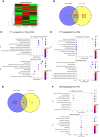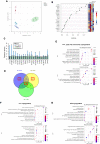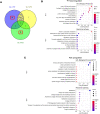Global analyses and potential effects of extracellular vesicles on the establishment of conceptus implantation during the peri-implantation period
- PMID: 37495510
- PMCID: PMC10602766
- DOI: 10.1262/jrd.2023-044
Global analyses and potential effects of extracellular vesicles on the establishment of conceptus implantation during the peri-implantation period
Abstract
Intrauterine extracellular vesicles (EVs) are involved in establishing proper conceptus-endometrial communication, which is essential for conceptus implantation and subsequent successful placentation. Despite several studies on intrauterine EVs, the composition and quantitative changes in conceptus and endometrial EVs, as well as the effects of intrauterine EVs on endometrial epithelial cells (EECs) during the peri-implantation period, have not been well characterized. To elucidate global changes in proteins in EVs extracted from uterine flushings (UFs) during the pre-implantation (P17), just-implantation (P20), and post-implantation (P22) periods, the datasets of the proteome iTRAQ analysis were compared among P17, P20, and P22 EVs. These analyses revealed that the composition and function of proteins in the EVs changed dramatically during peri-implantation in cattle. Notably, intrauterine P17 EVs affected the high expression of "Developmental Biology" and "morphogenesis of an endothelium" compared with those in P20 and P22 EVs. Furthermore, P20 EVs had the functions of the high expression of "mitochondrial calcium ion homeostasis" and "Viral mRNA Translation" compared with those in P17 EVs. Transcripts extracted from EECs treated with P17, P20, or P22 EVs were subjected to RNA-seq analysis. These analyses identified 60 transcripts in EECs commonly induced by intrauterine EVs recovered from P17, P20, and P22, a large number of which were associated with "type I interferon signaling pathway". Collectively, these findings reveal the presence and multiple functions of EVs that are potentially implicated in facilitating conceptus implantation into the uterine epithelium during the peri-implantation period.
Keywords: Cow; Endometrial epithelial cells; Extracellular vesicles (EVs); Implantation; Pregnancy.
Conflict of interest statement
The authors declare that there are no conflicts of interest associated with this manuscript.
Figures




Similar articles
-
Effects of miR-98 in intrauterine extracellular vesicles on maternal immune regulation during the peri-implantation period in cattle.Sci Rep. 2019 Dec 30;9(1):20330. doi: 10.1038/s41598-019-56879-w. Sci Rep. 2019. PMID: 31889113 Free PMC article.
-
IFNT-independent effects of intrauterine extracellular vesicles (EVs) in cattle.Reproduction. 2020 May;159(5):503-511. doi: 10.1530/REP-19-0314. Reproduction. 2020. PMID: 32103820
-
The effect of bta-miR-26b in intrauterine extracellular vesicles on maternal immune system during the implantation period.Biochem Biophys Res Commun. 2021 Oct 8;573:100-106. doi: 10.1016/j.bbrc.2021.08.019. Epub 2021 Aug 9. Biochem Biophys Res Commun. 2021. PMID: 34403805
-
Emerging Role of Extracellular Vesicles in Embryo-Maternal Communication throughout Implantation Processes.Int J Mol Sci. 2020 Aug 1;21(15):5523. doi: 10.3390/ijms21155523. Int J Mol Sci. 2020. PMID: 32752293 Free PMC article. Review.
-
Extracellular vesicles: Focus on peri-implantation period of pregnancy in pigs.Mol Reprod Dev. 2023 Jul;90(7):634-645. doi: 10.1002/mrd.23664. Epub 2023 Jan 16. Mol Reprod Dev. 2023. PMID: 36645872 Review.
Cited by
-
Ovine conceptuses express phospholipase inhibitory genes on days 14-15 of pregnancy, interacting with IFNT pathways.Reproduction. 2025 Jan 11;169(2):e240286. doi: 10.1530/REP-24-0286. Print 2024 Feb 1. Reproduction. 2025. PMID: 39606929 Free PMC article.
-
Epithelial-Mesenchymal Transitions Leading to Conceptus Adhesion in Ruminants: Early Pregnancy Events in Cattle.Int J Mol Sci. 2025 Apr 16;26(8):3772. doi: 10.3390/ijms26083772. Int J Mol Sci. 2025. PMID: 40332451 Free PMC article. Review.
References
-
- Wiltbank MC, Baez GM, Garcia-Guerra A, Toledo MZ, Monteiro PL, Melo LF, Ochoa JC, Santos JE, Sartori R. Pivotal periods for pregnancy loss during the first trimester of gestation in lactating dairy cows. Theriogenology 2016; 86: 239–253. - PubMed
-
- Spencer TE, Sandra O, Wolf E. Genes involved in conceptus-endometrial interactions in ruminants: insights from reductionism and thoughts on holistic approaches. Reproduction 2008; 135: 165–179. - PubMed
-
- Forde N, Carter F, Fair T, Crowe MA, Evans AC, Spencer TE, Bazer FW, McBride R, Boland MP, O’Gaora P, Lonergan P, Roche JF. Progesterone-regulated changes in endometrial gene expression contribute to advanced conceptus development in cattle. Biol Reprod 2009; 81: 784–794. - PubMed
-
- Forde N, Carter F, Spencer TE, Bazer FW, Sandra O, Mansouri-Attia N, Okumu LA, McGettigan PA, Mehta JP, McBride R, O’Gaora P, Roche JF, Lonergan P. Conceptus-induced changes in the endometrial transcriptome: how soon does the cow know she is pregnant? Biol Reprod 2011; 85: 144–156. - PubMed

